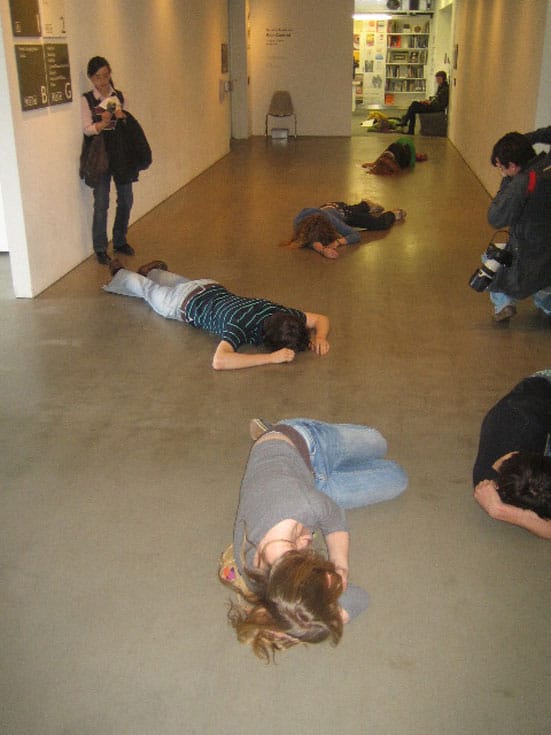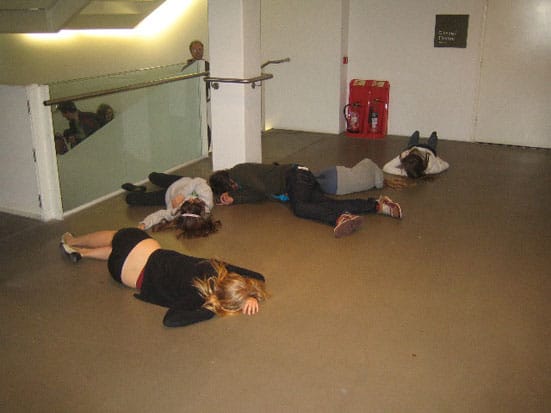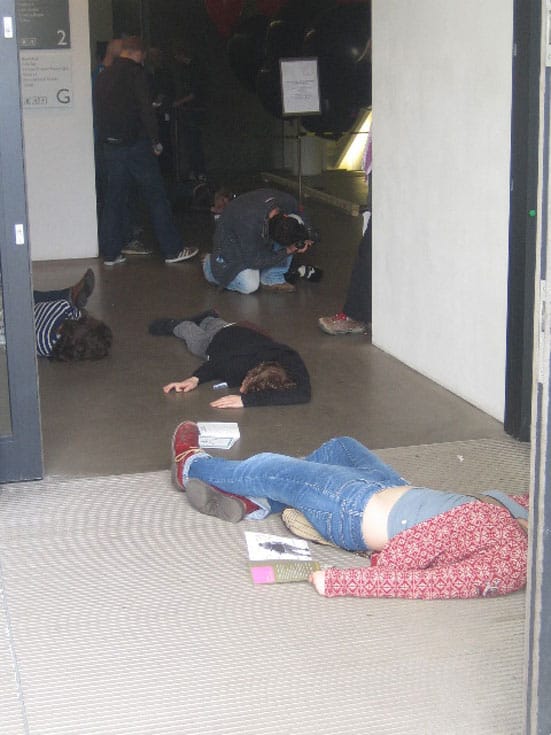Fall loudly to the ground. Be Inconspicuous. Do not laugh or interact with the audience.
These are instructions I received from artist Phoebe Davies when I participated in her live work Thud at the Whitechapel Gallery and The Arnolfini in Bristol. Phoebe graduated in 2007 from Wimbledon College of Art.
During Thud gallery-goers fall loudly to the floor. It's only when you notice that these supposedly impromptu fallers fall in sequence, like dominoes, and hold the position they landed in that you realise that there isn't an invisible force knocking them off their feet, they aren't blown away by the art works but they are part of something.
I've taken part in two performances of Thud and have really enjoyed the experience. Each time has been completely different – in Bristol I think we shocked a lot of people and the entire gallery stilled as we all lay on the floor; in London I think we got in the way of the party and were more like obstacles than works of art. Perhaps that reflects the nature of the events we were part of as well as the host cities. There were also far more voluntary fallers in London – which makes me think that Londoners are more used to random participation (who hasn’t attended or witnessed a Flashmob)?
Trendsetters and future forecasters identified that increasingly consumers want experiences over possessions. This is now a recognisable trend and I think that it might explain the willingness with which people have gotten involved and formed Phoebe’s art. I met with Phoebe to see how she feels about this, how she recruits and manages her volunteers, and why offering her concepts to, and working on them with the public is so important to her. Getting the audience involved in performances isn’t radical but relying completely on strangers to be your art is.
SB: What does Thud mean to you?
PD: My work varies between subtle durational performance and live movement that invades people’s lives and personal space for a short period of time before becoming lost back into normality.
I strive to make site/situation specific work for the general public. I have no set audience.
I am interested in artwork that can be mistaken as the everyday. I hope to challenge perceptions of normality in social situations, assumptions of how one is supposed to behave. And I also try to investigate the roles and boundaries between artist/audience I’m interested in work that does not have a clear beginning and end. I hope to make work with people who may not necessarily call themselves artists.
SB: How do you get so many people to take part in your performances - do you pay them?
PD: I don’t have any money. But it’s not that simple. I don’t make my work to earn money. If I could I would offer to pay people’s travel but I don’t want to pay people to be ‘actors’ because it’s not about that, they’re just moving in a specific way. One of the great things about Thud at Arnolfini was that we used lots of kids from local schools. I went and spoke at a sixth form because I wanted to introduce Live Art to a younger audience because when I was at school and even during my foundation course I didn’t know anything about live work apart from the body based stuff that gets in the papers [Franko B]. I didn’t know you could make art that spanned boundaries between music, dance, movement, light, and that you don’t need “permission” to make work especially site specific work or live work. You don’t realise that you can just go and make a piece of work on the street – that anyone can just pitch up.
SB: Did you notice you used ‘we’ instead of ‘I’ then?
PD: I only say that because I think it’s a joint effort and even though it’s my conceptual idea and I’m directing the performance it’s still a collaborative piece of work.
SB: So you would pay people if you could afford it?
PD: Yes and that would be for their time and their travel expenses. But that would be because I want to have people who want to be part of the performance so other things I do that last longer than a few weeks I would want to be able to cover their expenses so for example if they were taking time off their job. I want to offer it to people who want to be part of it and I don’t want money to be an obstacle. But I wouldn’t pay them like a cast – they’re not a cast. In Bristol for example none of those kids had ever even been in that gallery. Money would just make the opportunity available to more people.
SB: Do you think Thud could evolve further? Have you considered staging it as a Flash mob, say in the Turbine Hall of the Tate Modern?
PD: Thud is difficult because like all live work you can’t evaluate it until it’s publicly shown – it’s not like with paintings where you can stand back and consider them. And I am going to do it more because I think it can be better. Thud would have to change and evolve to be shown in a public place [not an art space] because people are so hysteric – especially in London with terrorism and gun crime, if you suddenly saw thirty people fall to the ground you’d think something wrong had happened and it’s not meant to scare people it’s meant to tip normality. So the movement or something would have to change. But also I think these difficulties enrich it and I want to make art where it wouldn’t usually happen - my piece in Camberwell 12 Lights was brilliant because even though it was difficult it was so rewarding and worked really well because people that lived there came out to see what was going on and were really interested in it, we had three young teenage boys who followed the whole piece, they were so intrigued because they couldn’t believe that you could dance anywhere, on the streets or through bus stops or car parks.
SB: What’s 12 Lights?
PD: It’s a site specific performance that happens twelve times during the year – it’s an ad-hoc movement piece that happens once a month along London’s South Bank it uses performers and dancers who move with a bright white light in public space during the hours of darkness. It’s unannounced, not publicised it can be seen by 200 people queuing for the London Eye or by two joggers. It’s aesthetically pleasing, a spectacle so even though it invades public and personal space it doesn’t impose or agitate the viewer. I’ve been working with dancers from Roehampton University for the past six months and we’re a collaborative performance group that is led by Holly Blakey and myself. We were recently asked to perform 12 Lights in the streets of Camberwell during Camberwell Arts Festival 2008.
SB: So these dancers aren’t so much giving up their time but artists as well as far as you’re concerned?
PD: Of course they are.
SB: Do all your pieces rely on audience participating or interaction?
PD: They don’t but I think they rely on a live experience and whether that’s with one person viewing it or a hundred it only exists in the present.
SB: So thinking of Thud specifically do you find it difficult to explain your work to the public you want to work with?
PD: Not if I have enough time – but if you only have ten minutes to explain it to people just before it happens then yes. But that’s my organisation and that’ll get better.
SB: How do strangers usually respond when you direct them to fall over on cue?
PD: Well if they don’t want to do they won’t be in it. But if people want to be part of it then they will.
SB: Do your volunteers follow your instructions accurately do you find it frustrating working with strangers? I think it’s incredibly trusting what you do.
PD: Mostly people do yes. It’s not frustrating because if it doesn’t happen the way I want it to happen it’s because I haven’t conveyed it strongly enough. So it’s my issue and I have to realise that next time I have to emphasise things – like not to talk to anyone straight afterwards. There are people I wouldn’t ask to be part of my work again as well.
To find out more about Phoebe's work please visit www.newworknetwork.org.uk/phoebedavies
Samantha Bond

Phoebe Davies
‘Thud’ 2008

Phoebe Davies
‘Thud’ 2008

Phoebe Davies
‘Thud’ 2008